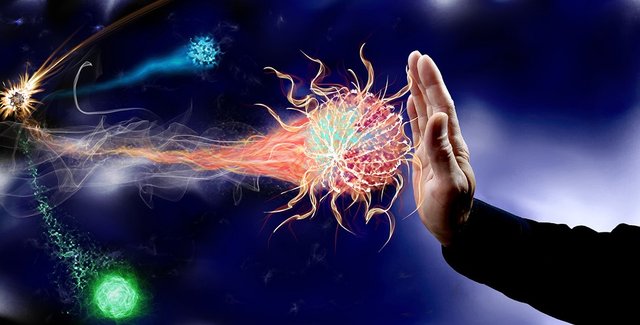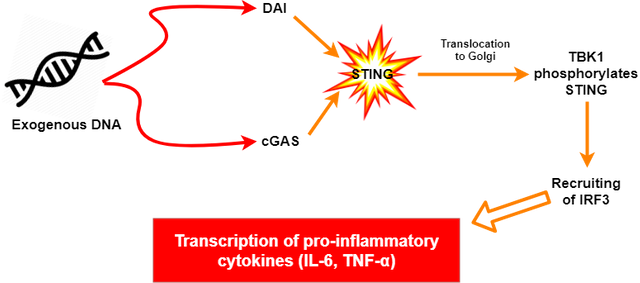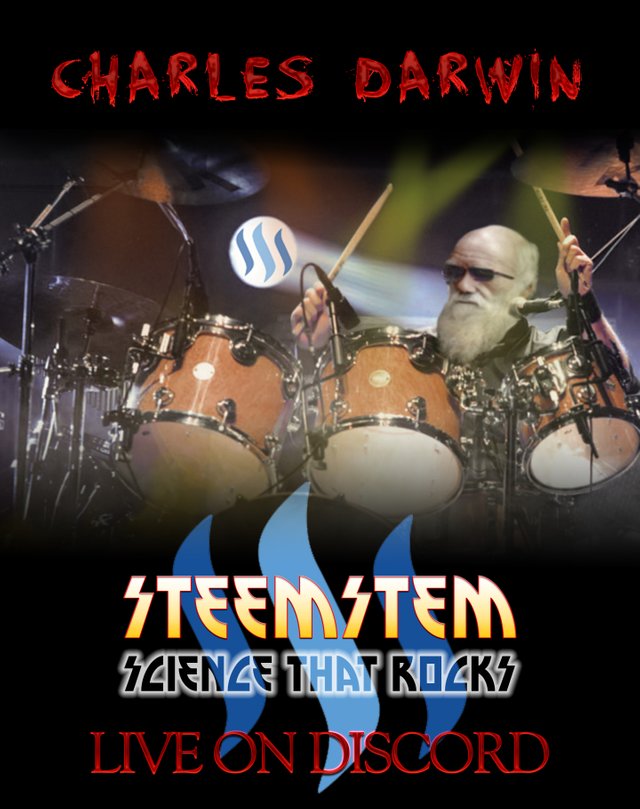Stinging cancer
Stinging cancer
A few weeks ago I wrote about how a mutation in bats enables them to withstand viral infections. The protein in question is called “stimulator of interferon genes” or STING and it’s responsible for the activation of the immune system as a response to the presence of exogenous DNA in the cytoplasm of a cell.
 Image CCO Creative Commons
Image CCO Creative Commons
 Image CCO Creative Commons
Image CCO Creative Commons I became curious about it so I decided to do some more reading to fully understand how STING works. While reading, I found several scientific papers linking the activity of STING to viral infections (Sokolowska and Nowis 2018) but also to signaling in cancer cells, so it seems to be a big deal.
The STING pathway
STING is often located in the endoplasmic reticulum (ER). As I mentioned earlier, this protein is activated by the presence of DNA in the cytoplasm (remember that the DNA should be in the nucleus, cytoplasmic DNA could often mean that a virus has infected a cell).

Image made by the author

Image made by the author
However, DNA does not activate STING directly, there are several different sensors in the cytoplasm of a cells, thus there are several different ways to activate STING. The main two are the DNA-dependent activator of interferon (DAI) (Wu and Chen 2014) and the cyclic GMP-AMP synthase (cGAS) (Ablasser et al. 2013). Upon activation, STING translocate from the ER to the Golgi apparatus. Here it interacts with a protein called TBK1 that phosphorylates STING causing the protein to fold and thus change function (Liu et al. 2015; Tanaka and Chen 2012). The phosphorylated form of STING can recruit a transcription factor called IRF3 that is able to promote the transcription of pro-inflammatory genes like the ones encoding for IL-6 or TNF-α (Ishikawa, Ma, and Barber 2009; Woo et al. 2014).
So, all this to say that STING can trigger the synthesis of pro-inflammatory proteins and type I interferons, thus activating the immune system.
 Image CCO Creative Commons
Image CCO Creative Commons What about cancer cells?
There is much we still don’t know about STING, but something we learned is that during the latest stages of the disease, cancer cells stop producing STING (Xia et al. 2016) and the suppression of STING activity seems to be quite common in several different types of cancer. However, STING is also a target of several different viruses that suppress its activity by inhibiting the downstream effectors of STING (Ronco et al. 1998; Yuen et al. 2016). The advantages for cancer cells and viruses of the suppression of STING are obvious, by suppressing its activity they can avoid alerting the immune system. So, suppression of STING activity could be a way for cancer cells to escape from our immunosurveillance. For us, STING could be an interesting target in the therapies against cancer, STING agonists were already shown to induce death of some cancer cells.
References
Ablasser, Andrea et al. 2013. “CGAS Produces a 2′-5′-Linked Cyclic Dinucleotide Second Messenger That Activates STING.” Nature 498(7454): 380–84. http://www.nature.com/articles/nature12306.
Ishikawa, Hiroki, Zhe Ma, and Glen N. Barber. 2009. “STING Regulates Intracellular DNA-Mediated, Type I Interferon-Dependent Innate Immunity.” Nature 461(7265): 788–92. http://www.nature.com/doifinder/10.1038/nature08476.
Liu, S. et al. 2015. “Phosphorylation of Innate Immune Adaptor Proteins MAVS, STING, and TRIF Induces IRF3 Activation.” Science 347(6227): aaa2630-aaa2630. http://www.sciencemag.org/cgi/doi/10.1126/science.aaa2630.
Ronco, L. V., A. Y. Karpova, M. Vidal, and P. M. Howley. 1998. “Human Papillomavirus 16 E6 Oncoprotein Binds to Interferon Regulatory Factor-3 and Inhibits Its Transcriptional Activity.” Genes & Development 12(13): 2061–72. http://www.genesdev.org/cgi/doi/10.1101/gad.12.13.2061.
Sokolowska, Olga, and Dominika Nowis. 2018. “STING Signaling in Cancer Cells: Important or Not?” Archivum Immunologiae et Therapiae Experimentalis 66(2): 125–32.
Tanaka, Yasuo, and Zhijian J Chen. 2012. “STING Specifies IRF3 Phosphorylation by TBK1 in the Cytosolic DNA Signaling Pathway.” Science signaling 5(214): ra20. http://www.ncbi.nlm.nih.gov/pubmed/22394562.
Woo, Seng-Ryong et al. 2014. “STING-Dependent Cytosolic DNA Sensing Mediates Innate Immune Recognition of Immunogenic Tumors.” Immunity 41(5): 830–42. http://linkinghub.elsevier.com/retrieve/pii/S1074761314003938.
Wu, Jiaxi, and Zhijian J. Chen. 2014. “Innate Immune Sensing and Signaling of Cytosolic Nucleic Acids.” Annual Review of Immunology 32(1): 461–88. http://www.annualreviews.org/doi/10.1146/annurev-immunol-032713-120156.
Xia, Tianli, Hiroyasu Konno, Jeonghyun Ahn, and Glen N. Barber. 2016. “Deregulation of STING Signaling in Colorectal Carcinoma Constrains DNA Damage Responses and Correlates With Tumorigenesis.” Cell Reports 14(2): 282–97. http://linkinghub.elsevier.com/retrieve/pii/S2211124715014539.
Yuen, Chun-Kit et al. 2016. “Suppression of Type I Interferon Production by Human T-Cell Leukemia Virus Type 1 Oncoprotein Tax through Inhibition of IRF3 Phosphorylation” ed. F. Kirchhoff. Journal of Virology 90(8): 3902–12. http://jvi.asm.org/lookup/doi/10.1128/JVI.00129-16.
Communities that support me are:

enlarge
Attribution-ShareAlike CC BY-SA
Reuse this image by copying and pasting this text with it:
Attribution-ShareAlike CC BY-SA by @elvisxx71 thanks to @aboutcoolscience and @davinci.art

IMMAGINE CC0 CREATIVE COMMONS, si ringrazia @mrazura per il logo ITASTEM. Click here and vote for @davinci.witness
Interesting. Though I don't think the Sting immune link can tell the entire story. For instance it is known that IL6 is abundant tumor microenvironment. Then IL6 and esp TNF can be both pro and anti-tumor depending on other factors. NFKb activation can act as prosurvival whereas JNK activation can cause TNF to kill the cell. I think interferon response, by DNA damage, induced by STING is of much more importance here than inflammatory cytokine response. However, since I haven't read the STING literature in detail, would like to know what do you think. Were there any experiment where genetic or pharmacological inhibition of TNF or IL6 led to ablation of protective role of STING in tumors? Also, thanks for bringing this protein to my notice. I should probably look at its activity in system I am using.
Hey @scienceblocks
Here's a tip for your valuable feedback! @Utopian-io loves and incentivises informative comments.
Contributing on Utopian
Learn how to contribute on our website.
Want to chat? Join us on Discord https://discord.gg/h52nFrV.
Vote for Utopian Witness!
I understand the general premise but I wouldn't venture to say that I understand this completely (didn't read the references).
So if the DNA is found outside the nucleus in the cytoplasm then STING is indirectly activated. In turn it activates the immune system as a response to the viral infection.
The activity of STING is targeted and lowered by some types of viruses and cancer cells and thus giving the advantage for their propagation without our immune system ever getting to know about it, maybe until much later.
I think you got it
Short but effective. Nice morning read! And I've got new pickup line for the conferences ;)
You are right, STING could be a great pickup line, probably you can use it also in bars not just in conferences ;)
:)
This post has been voted on by the steemstem curation team and voting trail.
There is more to SteemSTEM than just writing posts, check here for some more tips on being a community member. You can also join our discord here to get to know the rest of the community!
@aboutcoolscience You have received a 100% upvote from @taginspector because this post did not use any bidbots and you have not used bidbots in the last 30 days!
Upvoting this comment will help keep this service running.
You really did a great findings, am happy to be your fan...I wish to drop my little findings for better advancemnt of science. These Molecules termed as STING are nucleic acids,oligonucleotides, peptides, mutants, variants and active fragments which modulate innate and adaptive immunity in an animal . This gene's compositions are useful for the treatment of an immune-related disorder which includes, treating and preventing infection by modulating immunity. Since bats are mammals and humans are mammals...there is a possibility of infusing the gene or perhaps coding the gene sequence in man via gene modification. This advancement will add to our adaptive immunity.
You made a very nice point as regard supression of this STING by cancer cell and obviously its not far fetched though drugs like cisplatin and so many other drugs are used for cancer chemotherapy thus bringing a stop to the suppresion of STING.
Thanks to genetic modification, your post has proven that science has come to stay!
You really did a great findings, am happy to be your fan...I wish to drop my little findings for better advancemnt of science. These Molecules termed as STING are nucleic acids,oligonucleotides, peptides, mutants, variants and active fragments which modulate innate and adaptive immunity in an animal . This gene's compositions are useful for the treatment of an immune-related disorder which includes, treating and preventing infection by modulating immunity. Since bats are mammals and humans are mammals...there is a possibility of infusing the gene or perhaps coding the gene sequence in man via gene modification. This advancement will add to our adaptive immunity.
You made a very nice point as regard supression of this STING by cancer cell and obviously its not far fetched though drugs like cisplatin and so many other drugs are used for cancer chemotherapy thus bringing a stop to the suppresion of STING.
Thanks to genetic modification, your post has proven that science has come to stay!
This is s pretty cool blog post. Thanks for the information.
Pretty cool picture, but truly fascinating information.